Depositions
What Are the Depositions?
The depositions are sworn testimony given by the Harris’ and Klebolds during two different lawsuits: Rohrbough v. Harris and Taylor v. Solvay. Wayne and Kathy Harris were deposed during both lawsuits, but Tom and Sue Klebold were only deposed during Taylor v. Solvay.
These depositions were videotaped, taken by the plaintiffs (Rohrbough, Townsend, Kechter, Velasquez, Bernall, Fleming), and are the only recorded interviews given by the Harris and Klebold families. Depositions are often used in place of live testimony during a trial. However, both cases settled and never went to trial, so the depositions were never used.
According to Barry Arrington, one of the lawyers representing the families, said they paid $3,000 to have the depositions transcribed.
Rohrbough v. Harris was filed on April 19, 2000 and was settled and dismissed on August 13, 2003. Here is the docket report for this case.
Taylor v. Solvay was filed on October 19, 2001, settled for $10,000 and was dismissed on February 6, 2003. Here is the docket report for this case. And the docket for the appeal.
Two protective orders were issued over the depositions. The first on January 8, 2002 and the second on April 25, 2003. The latter replaced the former, and set rules of conduct for documents and information to be disclosed or produced including medical records.
After Rohrbough v. Harris was dismissed, On September 23, 2003, the judge ordered the disposal of evidence from the case, including the depositions.
Many people fought to have the depositions released and/or preserved rather than destroyed, including Mark Taylor, some of the victims’ families, Attorney General Ken Salazar, The Rocky Mountain News, and The National Archives (NARA).
When the judge heard objections to the destruction order, NARA participated as an amicus in order to preserve the depositions, and stated that the FRA likely prohibited their destruction. At this hearing, the judge found the depositions to be subject to the FRA and proposed that the depositions should to be transferred to NARA instead of destroyed and sealed from public access for 20 years.
In the end, the depositions were transferred to NARA, but the court has retained legal ownership. However, when the 20-year seal expires in 2027, ownership will automatically be transferred to NARA and the seal will be lifted.
Sue Klebold fought to have the depositions destroyed
Sue Klebold publicly claims she has always wanted the deposition transcripts released, but in reality, she fought hard to have them destroyed during the Taylor v. Solvay lawsuit.
From A Mother’s Reckoning:
“I am not allowed to talk about what happened during the depositions, except to say it was terribly painful and (I believe) unsatisfying for everyone involved.
The sealed transcripts of the proceedings gave the impression we were hiding something - again. I wanted to share the transcripts with the public. Why not? I was tired of fielding the implication I had something to hide when I spent my days hunting for answers. And, unlike the Basement Tapes, there was no danger of contagion from releasing them.
Unfortunately, it wasn't my decision. The judge decided to seal the depositions for twenty years.”
The truth:
When the National Archives and Records Administration (NARA) stepped in as an amicus asserting that the Federal Records Act prohibited the destruction of the depositions, the Klebolds objected to archiving their depositions and wanted them to be disposed of instead, while the Harris' preferred their depositions remain under seal permanently.
If the court ordered the depositions to be made public, the Klebolds wanted theirs heavily redacted and did not oppose the disposition of their depositions. In the end, the depositions were transferred to NARA under a 25-year seal set to expire in 2027.
See the following screen shots from court documents:
 |
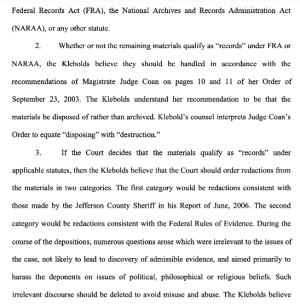 |
|---|---|
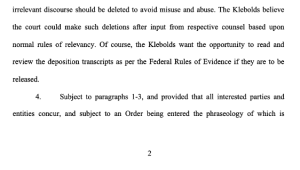 |
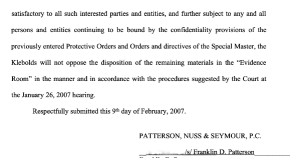 |
 |
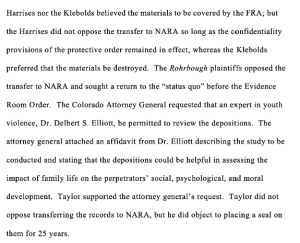 |
Dates of depositions given by the Harris’ and Klebolds
The following depositions were taken during the Rohrbough v. Harris lawsuit:
Judy Brown: Monday, July 28, 2003
Sue Klebold: Tuesday, July 29, 2003
Tom Klebold: Wednesday, July 30, 2003
Wayne Harris: Thursday, July 31, 2003
Kathy Harris: Friday, August 1, 2003
Source for dates: Columbine files to be destroyed: Victims' families want depositions made public, The Denver Post, September 26, 2003. (A live version of the full text of this article can be found here)
The Harris’ attorneys deposed Judy Brown for more than 5 hours as a fact witness in the Rohrbough case. She later tried to exercise her legal right to review her deposition, but was refused that right by the evidence room custodian (called the “Special Master”) Charles Kall.
A protective order required the depositions to be taken in Room A-535 at the courthouse rather than in the attorneys’ offices to keep key information confidential, including school records, criminal activity prior to the shooting, and the shooters’ plans to acquire firearms and explosives.
After the depositions, Dawn Anna, Lauren Townsend’s mother, made the following statement:
“We were not satisfied with many of the answers they gave, and we left the depositions shaking our heads in wonder at some of the things they said. But at least we got some answers, and after that we saw no point in continuing the litigation."
Where did the leaked deposition transcript page come from?
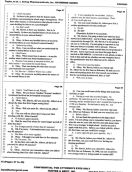
These four pages from what is alleged to be Kathy Harris’ deposition transcript would have come from Taylor v. Solvay. No copies were made of the Harris’ deposition transcripts given in Rohrbough v. Harris since the depositions were never signed. As such, counsel was not allowed to make copies, and there was only ever one copy of the videotaped depositions, transcripts, court reporter notes, and backup files kept in the Evidence Room at all times.
This alleged leaked transcript page was published to the research community in 2013 by community member and Mark Taylor advocate Ron Aigner, who claimed he was given the full deposition transcripts by Mark Taylor’s mother, Donna.
For a while, Aigner was allegedly giving copies of the depositions to select researchers along with other documents originating from Taylor’s former attorney, John DeCamp. Partial deposition transcripts are allegedly out there, but according to Aigner, all copies he gave to researchers are missing every other 4 pages. Aigner claims the transcript pages were printed double-sided and only one side was scanned on accident.
However, there's a major problem with this document: it's a complete fabrication.
The leaked deposition transcript is FAKE
If you look at the date on the alleged deposition transcript in the top right corner, the date reads 6/28/2002. Kathy Harris was deposed on August 1, 2003.
For proof that the depositions took place in 2003 and not in 2002, see this 9 News article published on Wednesday, July 30, 2003, which references Judy Brown having been deposed by the Harris' attorneys on "Monday." The Monday immediately prior to the article's publication was July 28, 2003.
Side note: in the document is a reference to "bates stamped/numbered" documents. Some people have wondered what that is. If you want to see what bates stamping looks like, it's the numbering system used in the bottom right corner on all pages released by Jefferson County, including the 11k report. It looks like this: JC-001-000345.

How did the depositions end up sealed?
On September 23, 2003, Magistrate Judge Patricia Coan ordered all depositions from Rohrbough v. Harris and Taylor v. Solvay to be disposed of by the court. Both cases were then consolidated to hear objections. In the end, they were ordered sealed rather than destroyed.
Mark Taylor objected to their destruction and filed an appeal (case no. 01-cv-02076). The Harris’ and Klebolds intervened in Taylor’s appeal holding the position that the depositions should be destroyed.
On April 2, 2007, Taylor won his appeal and the disposal was ordered reversed. The depositions were ordered to be transferred to NARA and sealed for 20 years, during which time the court would retain legal ownership. After 20 years, the seal would be lifted and legal custody would be granted to NARA.
This decision was appealed on April 26, 2007, by the Townsend and Rohrbough families. They filed an appeal (case no. 07-1186) on April 30, 2007. The appeal was denied on December 15, 2008.
After hearing arguments in favor of making the depositions public, Judge Babcock concluded:
"I am mindful that there is a legitimate public interest in these materials so that similar tragedies may hopefully be prevented in the future. I conclude, however, that the balance of interests still strikes in favor of maintaining strict confidentiality."
Craig Silverman, a local attorney and former prosecutor, told the Denver Post that destroying transcripts of depositions is unusual. "I have never heard of that happening before," Silverman said. "When the families publicly stated that they wanted the information released despite a protective order, that had to raise red flags with the judges overseeing the case," Silverman said.
Timeline of objections
On October 2, 2003, the Shoels family filed a motion opposing the order of destruction. This was overturned on September 22, 2004.
On October 7, 2003, the Schnurr family filed a motion opposing the order of destruction. This was denied on April 2, 2007.
On October 7, 2003, both the Rocky Mountain News and Colorado Attorney General Ken Salazar filed motions to intervene. Both were denied intervention, but were allowed to proceed as an amicus curiae.
Salazar had hoped to intervene in order to get secret documents released and planned to ask the court to modify the protective orders over the depositions and other records. He also planned to support youth violence expert, Dr. Del Elliott, in gaining access to the depositions for a study he was conducting.
What is the Federal Records Act?
The Federal Records Act (FRA) governs the management, retention, and disposal of federal records.
NARA is authorized to manage federal records under the FRA.
The court determined that since the depositions were deposited with the special master and “received” by the district court, they were determined to be federal records under the FRA and not personal property. Had they been determined to be personal property, they would have been returned to the families, who could then make them public. As federal records, the courts had the authority to determine their fate.
How the involved parties responded to the seal
The Harris’ did not oppose transferring the depositions to NARA as long as confidentiality provisions of the protective order remained in effect. However, the Klebolds preferred that the depositions be destroyed.
The Rohrboughs objected to the depositions being transferred to NARA and wanted them to be made public immediately.
Dr. Delbert S. Elliott, youth violence expert and director of the Center for the Study and Prevention of Violence at the University of Colorado, requested to view the depositions for a study he was conducting and was denied. Elliott abandoned his study because he couldn’t get access to the depositions.
Mark Taylor and the Rohrbough family appealed the judge’s decision to seal the depositions. Taylor appealed only the denial of Dr. Elliott’s access to the records, while the Rohrboughs argued that the depositions were not subject to the FRA and held that the depositions are their personal property and wanted to retain custody of them.
Rohrbough argued that the depositions are not “records” under the FRA and the district court had no authority to transfer them to NARA.
Both the Harris’ and Klebolds opposed transferring the depositions to NARA under the 20-year seal.
Mark Taylor didn’t object to transferring the depositions to NARA, but objected to the 20-year seal and objected to the court’s decision not to modify the protective order to keep information private. Taylor believed the public interest outweighed the need for maintaining confidentiality.
Since both cases settled and did not go to trial, the depositions were never used and were therefore not public record, which meant the court had no obligation to publicly release the depositions in any form.
The depositions are set to be released in 2027
The deposition transcripts remain in the care of the National Archives (NARA) and are set to be released in April 2027. However, some speculate there will be a lawsuit filed to intervene and make sure they are never released. We won't know if that's true until the time comes.